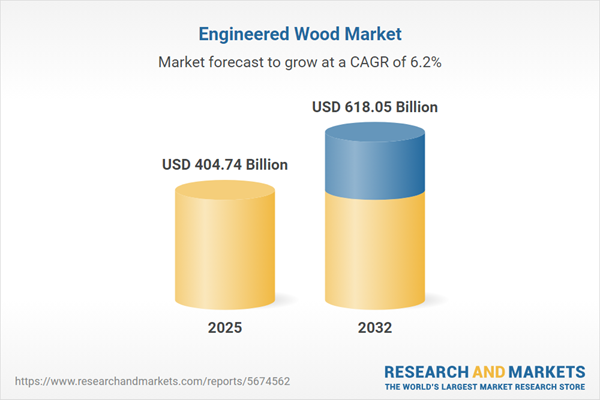Speak directly to the analyst to clarify any post sales queries you may have.
The engineered wood market is undergoing significant transformation, driven by sustainability requirements, regulatory changes, and advancements in product innovation. Senior leaders need actionable intelligence to navigate the evolving landscape, make confident investment decisions, and capitalize on emerging opportunities.
Market Snapshot: Engineered Wood Market Size and Growth Dynamics
The global engineered wood market grew from USD 381.42 billion in 2024 to USD 404.74 billion in 2025 and is projected to reach USD 618.05 billion by 2032, reflecting a strong CAGR of 6.21%. Growth is fuelled by expanding end-use sectors including construction, automotive, furniture, and packaging. Heightened demand for resource efficiency and certified sustainable materials positions engineered wood as a strategic choice for businesses focused on performance and long-term environmental impact.
Scope & Segmentation: Comprehensive Market Coverage
- Product Types: Laminated veneer lumber, medium density fiberboard (fire retardant, moisture resistant, standard MDF), oriented strand board, particleboard, decorative plywood, and structural plywood.
- Applications: Automotive and transportation (exterior panels, interiors), construction (commercial and residential), furniture and cabinets (kitchen, office, residential), packaging and pallets (boxes, crates, pallet systems).
- End Users: Automotive manufacturers, construction contractors, furniture manufacturers, packaging producers.
- Distribution Channels: Direct sales, distributor and dealer networks (retail, wholesale), B2B e-commerce platforms, company websites.
- Wood Species: Hardwood (birch, maple, oak), softwood (cedar, pine, spruce), and mixed wood.
- Regions: Americas (North and Latin America), Europe, Middle East, Africa, Asia-Pacific (including key markets such as the United States, China, India, Brazil, Germany, and Japan).
- Companies Profiled: Weyerhaeuser, West Fraser Timber, Louisiana-Pacific, Georgia-Pacific, Stora Enso, Kronospan, Arauco, EGGER Group, SCA, UPM-Kymmene among others.
Key Takeaways for Senior Decision-Makers
- Technological progress in adhesives and manufacturing is expanding engineered wood's performance advantages, which are relevant for modular and high-rise construction projects.
- Increasing regulatory emphasis on life cycle assessments and carbon reduction is accelerating the adoption of certified and low-embodied energy materials in design specifications.
- Circular economy practices, including recycled fiber recovery and waste minimization, are now foundational to sector competitiveness and value chain transparency.
- Digitalization—such as integrated production planning and predictive quality monitoring—is reshaping operational benchmarks for mills and fabricators worldwide.
- Regional nuances, from policy incentives in Europe to infrastructure growth in the Americas, create varied demand drivers, making tailored strategies essential for market penetration.
- Strategic partnerships with certification bodies and technology startups foster supply chain resilience and innovation, supporting long-term differentiation.
Assessing Tariff Impacts and Trade Realignment in Engineered Wood
The introduction of new United States tariff measures in 2025 has added complexity to global trade flows, pushing exporters and domestic producers to revisit sourcing strategies and vertical integration. These policy shifts have encouraged collaborative ventures and logistics optimization, enabling some market participants to sustain competitiveness and ensure supply continuity amid changing cost structures. Companies operating across value chains now prioritize adaptive sourcing, risk management, and proactive engagement in regional trade corridors.
Methodology & Data Sources
This report uses a robust blended methodology. Primary data was collected from executive and expert interviews throughout the engineered wood supply chain. Secondary sources include trade journals, regulatory filings, company reports, and government statistics. Advanced analytics, scenario modeling, and iterative expert review underpin the validity and replicability of the research findings.
Why This Report Matters for Engineered Wood Industry Leaders
- Enables informed decisions on R&D, supply chain investments, and go-to-market strategies by delivering comprehensive market segmentation and actionable trend analysis.
- Provides clarity on regional growth dynamics, competitive positioning, and the impact of regulatory and technological shifts for global and regional stakeholders.
Conclusion
The engineered wood market offers significant opportunities amid evolving regulations, sustainability demands, and innovation cycles. Strategic alignment with these forces will help businesses navigate complexity and secure growth in this dynamic sector.
Additional Product Information:
- Purchase of this report includes 1 year online access with quarterly updates.
- This report can be updated on request. Please contact our Customer Experience team using the Ask a Question widget on our website.
Table of Contents
3. Executive Summary
4. Market Overview
7. Cumulative Impact of Artificial Intelligence 2025
Companies Mentioned
The companies profiled in this Engineered Wood market report include:- Weyerhaeuser Company
- West Fraser Timber Co., Ltd.
- Louisiana-Pacific Corporation
- Georgia-Pacific LLC
- Stora Enso Oyj
- Kronospan Holdings Limited
- Arauco S.A.
- EGGER Group
- Svenska Cellulosa Aktiebolaget SCA
- UPM-Kymmene Corporation
Table Information
| Report Attribute | Details |
|---|---|
| No. of Pages | 183 |
| Published | October 2025 |
| Forecast Period | 2025 - 2032 |
| Estimated Market Value ( USD | $ 404.74 Billion |
| Forecasted Market Value ( USD | $ 618.05 Billion |
| Compound Annual Growth Rate | 6.2% |
| Regions Covered | Global |
| No. of Companies Mentioned | 11 |









